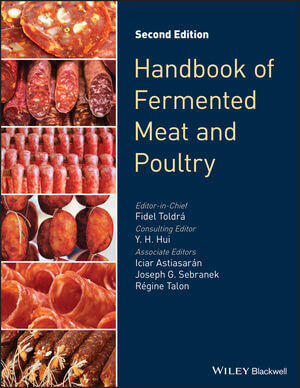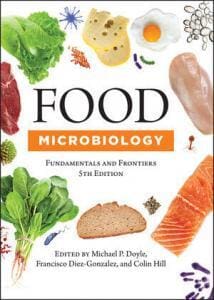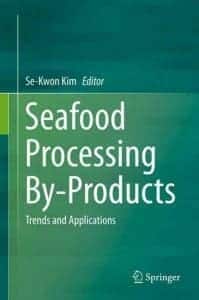Handbook of Fermented Meat and Poultry, 2nd Edition

Fermented meat products have been consumed for centuries in many different parts of the world and constitute one of the most important groups of food. Bacterial cultures are used in their manufacture to preserve the meat and confer particular textures and sensory attributes. Examples of fermented meats include salami, chorizo, pepperoni and saucisson.
This fully revised and expanded reference book on meat fermentation presents all the principle fermented meat products and the processing technologies currently used in their manufacture. The 54 chapters of this substantial book are grouped into the following sections:
- Meat fermentation worldwide: overview, production and principles
- Raw materials
- Microbiology and starter cultures for meat fermentation
- Sensory attributes
- Product categories: general considerations
- Semidry-fermented sausages
- Dry-fermented sausages
- Other fermented meats and poultry
- Ripened meat products
- Biological and chemical safety of fermented meat products
- Processing sanitation and quality assurance
There are five new chapters in the second edition that address the following topics: Smoking and new smoke flavourings; Probiotics; Methodologies for the study of the microbial ecology in fermented sausages; Low sodium in meat products; and Asian sausages.
Handbook of Fermented Meat and Poultry, Second Edition provides readers with a full overview of meat fermentation, the role of microorganisms naturally present and/or added as starter cultures, safety aspects and an account of the main chemical, biochemical, physical and microbiological changes that occur in processing and how they affect final quality. Finally, readers will find the main types of worldwide fermented meat products, typically produced in different areas, with the description of their main characteristics.
List of Contributors xvii
Preface xxi
Part I Meat Fermentation Worldwide: Overview, Production, and Principles 1
1 Dry-Fermented Sausages and Ripened Meats: An Overview 3
Fidel Toldra and Y.H. Hui
1.1 Introduction 3
1.2 Fermented sausages and ripened meats around the world 3
1.3 The importance of fermented sausages 5
Acknowledgement 6
References 6
2 Production and Consumption of Fermented Meat Products 7
Herbert W. Ockerman and Lopa Basu
2.1 Introduction 7
2.2 Current products 7
2.3 The Future 10
References 10
3 Principles of Meat Fermentation 13
Eero Puolanne and Esko Petaja-Kanninen
3.1 Introduction 13
3.2 Fermentation 14
3.3 Factors influencing fermentation 15
3.4 Proteolysis 15
3.5 Lipolysis 15
3.6 Antagonistic effects 16
References 16
4 Principles of Curing 19
Ronald B. Pegg and Karl O. Honikel
4.1 Definition of curing 19
4.2 History of curing 19
4.3 Legislation 20
4.4 Chemistry of nitrite and nitrate 20
4.5 Nitrite and nitrate in meat products 22
4.6 Nitrosomyoglobin (NOMb) 27
4.7 N-nitrosamine formation 28
4.8 Conclusion 29
References 29
5 Principles of Drying 31
Raul Grau, Ana Andres, and Jose M. Barat
5.1 Introduction 31
5.2 Basic principles of drying 31
5.3 Hurdle technology applied to dried meat and poultry products 32
5.4 Fundamentals of the drying of meat and poultry products 34
5.5 Drying kinetics modeling 35
5.6 Air conditioning and circulation in meat drying 35
References 36
6 Principles of Smoking 39
Zdzisław E. Sikorski and Izabela Sinkiewicz
6.1 Introduction 39
6.2 Wood-smoke composition 39
6.3 The preserving effect 40
6.4 The flavoring effect 41
6.5 Benefits and risks 42
6.6 Food engineering approach 43
6.7 Smoking procedures 45
References 45
Part II Raw Materials 47
7 The Biochemistry of Meat and Fat 49
Fidel Toldra and Milagro Reig
7.1 Introduction: muscle structure 49
7.2 Meat composition 49
7.3 Muscle proteases and lipases 51
7.4 Adipose tissue lipases 52
7.5 Post mortem muscle metabolism and quality 53
References 53
8 Ingredients 55
Jorge Ruiz and Trinidad Perez-Palacios
8.1 Introduction 55
8.2 Lean 55
8.3 Fat 56
8.4 Factors affecting the suitability of lean and fat for processing 56
8.5 Other ingredients 62
References 65
9 Additives 69
Pedro Roncales
9.1 Introduction 69
9.2 Acids and related additives 69
9.3 Antioxidants 70
9.4 Colorants 70
9.5 Emulsifiers 71
9.6 Flavor enhancers 72
9.7 Flavoring agents 73
9.8 Preservatives 74
9.9 Multipurpose additives: phosphates 75
References 76
10 Spices and Seasonings 79
Suey Ping Chi and Yun Chu Wu
10.1 Introduction 79
10.2 Ethnic preferences 79
10.3 Commonly used spices in processed meats 80
10.4 Botanical properties 80
10.5 Product forms and appearances 80
10.6 Chemical properties 80
10.7 Quality standards 81
10.8 Sensory properties 82
10.9 Applications in fermented meat processing 87
10.10 Conclusion 87
References 87
11 Casings 89
Yun Chu Wu, Suey Ping Chi, and Souad Christieans
11.1 Introduction 89
11.2 Natural casings 89
11.3 Artificial casings 93
11.4 Regulatory compliance 94
11.5 Handling casings 95
11.6 Quality determination 95
11.7 Conclusion 96
References 96
Part III Microbiology and Starter Cultures 97
12 Microorganisms in Traditional Fermented Meats 99
Sabine Leroy, Isabelle Lebert, and Regine Talon
12.1 Introduction 99
12.2 Traditional sausage manufacture 99
12.3 Description of ecosystems 100
12.4 Identification of technological microbiota 102
12.5 Conclusion 103
References 103
13 The Microbiology of Fermentation and Ripening 107
Margarita Garriga and Teresa Aymerich
13.1 Introduction 107
13.2 The manufacture of fermented sausages 107
13.3 Technological microflora 108
13.4 Spoilage microflora 111
13.5 Foodborne pathogens 111
13.6 Starter cultures 111
References 112
14 Bacteria 117
Pier Sandro Cocconcelli and Cecilia Fontana
14.1 Introduction 117
14.2 Bacterial starter cultures used for fermented meats 117
14.3 Starter cultures: technological advantage in the meat environment 120
14.4 Safety of selected meat starter-culture bacteria 123
14.5 Conclusion 124
References 124
15 Bioprotective Cultures 129
Graciela Vignolo, Patricia Castellano, and Silvina Fadda
15.1 Introduction 129
15.2 Starter cultures for meat fermentation 129
15.3 Competitiveness of starter cultures 131
15.4 Bioprotective cultures for fermented meat products 132
15.5 Conclusion 135
References 135
16 Yeasts 139
M.D. Selgas and M.L. García
16.1 Introduction 139
16.2 Presence of yeasts on meat sausages 139
16.3 Role of yeasts in meat products 140
16.4 Yeast starter cultures 144
References 144
17 Molds 147
Elettra Berni
17.1 Introduction 147
17.2 Fungal contamination in ripening environments 147
17.3 Fungal starter cultures 148
17.4 Lipolytic and proteolytic activity of starter cultures 149
17.5 Growth and competitiveness of starter cultures 149
17.6 Conclusion 151
References 151
18 Probiotics 155
Keizo Arihara
18.1 Introduction 155
18.2 Probiotics and probiotic foods 155
18.3 Probiotics and meat products 156
18.4 Prebiotics and synbiotics 157
18.5 Conclusion 158
References 158
19 The Genetics of Microbial Starters 161
Jamila Anba-Mondoloni, Marie-Christine Champomier-Verges, Monique Zagorec, Sabine Leroy, Emilie Dordet-Frisoni, Stella Planchon, and Regine Talon
19.1 Introduction 161
19.2 Chromosome elements 161
19.3 Plasmids 163
19.4 DNA transfer and genetic tools 163
19.5 Post-genomics studies 164
References 165
20 The Influence of Processing Parameters on Starter Culture Performance 169
F. Leroy, T. Goudman and L. De Vuyst
20.1 Introduction 169
20.2 Influence of raw materials 169
20.3 Influence of temperature 170
20.4 Influence of added fermentable carbohydrates 171
20.5 Influence of salting and drying 172
20.6 Influence of curing agents 173
20.7 Influence of spices 173
20.8 Influence of sausage caliber 173
20.9 Influence of maturation and molding 173
20.10 Conclusion 174
Acknowledgments 174
References 174
21 Methodologies for the Study of Microbial Ecology in Fermented Sausages 177
Valentina Alessandria, Kalliopi Rantsiou, Paola Dolci and Luca Cocolin
21.1 Introduction 177
21.2 Molecular approaches to the study of microbial ecology in fermented sausages 178
21.3 Culture-independent methods 178
21.4 Definition of the microbial ecology in fermented sausages by culture-independent methods 180
21.5 Culture-dependent methods 182
21.6 Definition of the microbial ecology in fermented sausages by culture-dependent methods 183
21.7 Conclusion 184
References 185
Part IV Sensory Attributes 189
22 Sensory Analyses-General Considerations 191
Asgeir Nilsen, Marit Rødbotten, Ken Prusa, and Chris Fedler
22.1 Introduction 191
22.2 Sensory methods 191
22.3 Sensory analysis of fermented meat products 192
References 194
23 Color 195
Jens K.S. Møller, Sisse Jongberg, and Leif H. Skibsted
23.1 Introduction 195
23.2 Color-forming compounds 195
23.3 Chemistry of meat color 195
23.4 Influence of fermentation parameters on color 197
23.5 Bacterial role in meat color 199
23.6 Natural and organic cured meat 200
23.7 Color stability of cured meat products 201
23.8 Conclusion 203
Acknowledgment 203
References 203
24 Texture 207
Shai Barbut
24.1 Introduction 207
24.2 Texture of commercial products 207
24.3 Texture development during fermentation 207
24.4 Texture development during ripening 210
24.5 Texture development during cooking (nondried/semidried) 211
24.6 Effects of processing parameters 213
24.7 Effects of product modification with non-meat ingredients 214
24.8 Conclusion 214
References 215
25 Flavor 217
Monica Flores and Alicia Olivares
25.1 Introduction 217
25.2 Precursor generation reactions of fermented meat flavor 217
25.3 Volatile compound generation reactions 218
25.4 Extraction and identification of volatile compounds 218
25.5 Elucidation of aroma active compounds 220
25.6 Relevance of volatile compounds in fermented meats 220
References 224
Part V Product Categories: General Considerations 227
26 Composition and Nutrition 229
Daniel Demeyer
26.1 Introduction 229
26.2 Nutrient supply from meat and meat products 229
26.3 Meat and meat products in healthy nutrition 232
26.4 Recommended meat intakes 233
26.5 Effects of fermentation on the nutritional and health properties of meat 234
References 236
27 Functional Dry-Fermented Sausages 241
Diana Ansorena and Iciar Astiasaran
27.1 Introduction 241
27.2 Modification of the mineral content in dry-fermented sausages 241
27.3 Fat modifications in dry-fermented sausages 243
27.4 Incorporation of fiber into dry-fermented sausages 245
27.5 Use of dry-fermented sausages as probiotics 246
27.6 Incorporation of vitamins 246
27.7 Conclusion 247
References 247
28 Low-Sodium Products 251
Fidel Toldra and Jose M. Barat
28.1 Introduction 251
28.2 Relevance of salt in fermented meats 251
28.3 Strategies for sodium reduction 252
28.4 Effects of sodium reduction on quality and safety 253
References 254
29 International Standards: United States 259
Elizabeth Boyle and Melvin C. Hunt
29.1 Introduction 259
29.2 US regulatory process 259
29.3 Regulatory definitions and specifications 260
29.4 HACCP options 261
29.5 Validation 261
References 261
30 International Standards: Europe 263
Reinhard Fries
30.1 Introduction 263
30.2 Quality 263
30.3 Microbiological safeguarding in food chains 266
30.4 Generating microbiological data in practice 268
30.5 Microbiological criteria for foodstuffs in Reg. (EC) 2073/2005 270
References 270
31 Packaging and Storage 273
Byungrok Min and Dong Uk Ahn
31.1 Introduction 273
31.2 Functions of food packaging 273
31.3 Packaging materials 274
31.4 Packaging systems 276
31.5 Storage 279
References 279
Part VI Semidry-Fermented Sausages 281
32 US Products-Semidry Sausage 283
Robert E. Rust
32.1 Introduction 283
32.2 Methods of acidification 283
32.3 Food safety 283
32.4 Manufacturing processes 284
32.5 Different types of US semidry sausage 285
Reference 285
33 European Products 287
Friedrich-Karl Lucke
33.1 Introduction 287
33.2 Definition of “semidry-fermented sausage” in Europe 287
33.3 General remarks on the manufacture of European-style semidry-fermented sausages 288
33.4 Types of European-style semidry-fermented sausage 290
33.5 Safety and stability 291
33.6 Conclusion 291
References 291
Part VII Dry-Fermented Sausages 293
34 US Products-Dry Sausage 295
Robert Maddock
34.1 Introduction 295
34.2 European versus US products 295
34.3 Definitions 295
34.4 US manufacturing processes for dried sausages 296
34.5 Basic formulations and processes for selected large-diameter dried sausages 297
34.6 Safe production of dried sausages in the United States 298
34.7 Process control points for dried sausage manufacturing 298
References 299
35 Mediterranean Products 301
Eva Hierro, Manuela Fernandez, Lorenzo de la Hoz, and Juan A. Ordon˜ ez
35.1 Introduction 301
35.2 Production of Mediterranean dry-fermented sausages 301
35.3 Changes during ripening of Mediterranean dry-fermented sausages 303
35.4 Innovation in Mediterranean dry-fermented sausages 306
35.5 Conclusion 308
References 309
36 Northern European Products 313
Askild Holck, Even Heir, Tom C. Johannessen, and Lars Axelsson
36.1 Introduction 313
36.2 Characteristics of Northern European sausages 313
36.3 Sausages of Central Europe 316
36.4 Sausages of Eastern Europe 317
36.5 Sausages of the Nordic countries 318
References 320
37 Asian Products 321
Ming-Ju Chen, Rung-Jen Tu, and Sheng-Yao Wang
37.1 Introduction 321
37.2 Chinese products 321
37.3 South East Asian products 324
37.4 Himalayan fermented meat products 326
References 326
Part VIII Fermented Products from Poultry and Other Meats 329
38 Fermented Poultry Sausages 331
E. Arnaud, S.J. Santchurn, and A. Collignan
38.1 Introduction 331
38.2 Fermented poultry sausages 332
38.3 Other fermented products 336
References 336
39 Fermented Sausages from Other Meats 339
Emin Burcin Ozvural and Halil Vural
39.1 Introduction 339
39.2 Fermented products from other meats 339
39.3 Scientific studies on other meats 340
References 342
Part IX Ripened Meat Products 345
40 US Products-Dry-Cured Hams 347
Dana J. Hanson, Gregg Rentfrow, M. Wes Schilling, W. Benjy Mikel, Kenneth J. Stalder, and Nicholas L. Berry
40.1 Introduction 347
40.2 Country ham standards 347
40.3 Commercial dry-cured ham production in the United States 348
40.4 Ham curing at home 351
40.5 Safety 352
40.6 Cooking 352
40.7 Research 352
References 353
41 Central and South American Products 355
Silvina Fadda and Graciela Vignolo
41.1 Introduction 355
41.2 Meat consumption and habits 355
41.3 Meat production in Latin American countries 355
41.4 Typical meat products, microbial ecology, and safety risks 356
41.5 Conclusion 359
References 359
42 Mediterranean Products 361
Mario Estevez, Sonia Ventanas, David Morcuende, and Jesus Ventanas
42.1 Introduction 361
42.2 Production of dry-cured hams 361
42.3 Spanish dry-cured hams 362
42.4 Italian dry-cured hams 365
42.5 French dry-cured hams 367
References 368
43 Nordic Products 371
Torunn Thauland Haseth, Gudjon Thorkelsson, Eero Puolanne, and Maan Singh Sidhu
43.1 Introduction 371
43.2 Norwegian fenalår 371
43.3 Norwegian pinnekjøtt 372
43.4 Norwegian dry-cured ham (spekeskinke) 373
43.5 Icelandic hangikjöt 373
43.6 Faroese skerpikjøt 373
43.7 Greenlandic mattaq and igunaq 374
43.8 Finnish Lapin Poron kylmäsavuliha 374
43.9 Finnish Lapin Poron kuivaliha 375
References 375
44 Asian Products 377
Guang-Hong Zhou and Gai-Ming Zhao
44.1 Introduction 377
44.2 History and traits of Jinhua ham 377
44.3 Processing of Jinhua ham 377
44.4 Possible factors causing differences in Chinese dry-cured hams 380
References 381
Part X Biological and Chemical Safety of Fermented Meat Products 383
45 Spoilage Microorganisms: Risks and Control 385
Marie-Christine Champomier-Verges and Monique Zagorec
45.1 Introduction 385
45.2 Putative spoilage microorganisms 385
45.3 Examples of spoilage occurring in fermented sausage 386
45.4 Strategies for spoilage control 386
45.5 Conclusion 387
References 388
46 Pathogens: Risks and Control 389
Panagiotis Skandamis and George-John E. Nychas
46.1 Introduction 389
46.2 Hazard identification 390
46.3 Hazard characterization: defense mechanism 390
46.4 Exposure assessment 392
46.5 Control measures 406
References 409
47 Biogenic Amines: Risks and Control 413
M. Carmen Vidal-Carou, M. Teresa Veciana-Nogues, M. Luz Latorre-Moratalla, and Sara Bover-Cid
47.1 Introduction: biogenic amine classification and relevance 413
47.2 Health risks of biogenic amines in fermented sausages 413
47.3 Aminogenesis in fermented sausages and measures for its control 415
47.4 Conclusion 424
References 424
48 Toxic Compounds of Chemical Origin 429
Milagro Reig and Fidel Toldra
48.1 Introduction 429
48.2 N-nitrosamines 429
48.3 Polycyclic aromatic hydrocarbons (PAHs) 430
48.4 Oxidation 431
48.5 Veterinary drug residues 431
48.6 Environmental contaminants 433
References 433
49 Foodborne Outbreaks 435
Colin Pierre
49.1 Introduction 435
49.2 Staphylococcus aureus 435
49.3 Salmonella spp. 435
49.4 Verotoxigenic strains of Escherichia coli 436
49.5 Yersinia enterocolitica 437
49.6 Listeria monocytogenes 437
49.7 Thermotolerant Campylobacter 438
49.8 Parasites 438
49.9 Conclusion 438
References 438
Part XI Processing Sanitation and Quality Assurance 441
50 Basic Sanitation 443
Beatriz Melero, Ana M. Diez, and Jordi Rovira
50.1 Introduction 443
50.2 Raw materials and ingredients 443
50.3 Plant environment 443
50.4 Personnel hygiene and training 446
References 448
51 Processing Plant Sanitation 451
Jordi Rovira, Ana M. Diez, and Beatriz Melero
51.1 Introduction 451
51.2 Fermented meat products and poultry 451
51.3 Fermented sausage processing plant sanitation 452
51.4 Methods of evaluating the sanitation state of a plant 457
51.5 Final considerations 458
References 458
52 Quality Control 461
Fidel Toldra, Monica Flores, and M. Concepcion Aristoy
52.1 Introduction 461
52.2 Quality controls at each stage of processing 461
52.3 Control of drying 462
52.4 Control of sensory quality 462
References 466
53 HACCP: Hazard Analysis and Critical Control Points 469
M.J. Fraqueza and A.S. Barreto
53.1 The HACCP concept: why use it 469
53.2 HACCP model for fermented sausages: a generic model for HACCP implementation in traditional establishments and small fermented sausage plants 470
53.3 Validation of the operative HACCP plan 483
53.4 Revision of the HACCP plan 483
53.5 Certification of food safety management systems 484
References 484
54 Quality Assurance Plan 487
Friedrich-Karl Lucke
54.1 Introduction 487
54.2 General remarks on the purchase and selection of raw materials 487
54.3 Quality assurance plans and records for fermented sausages 488
54.4 Quality assurance plans and records for raw dry hams 490
54.5 Slicing, packaging, and storage of fermented sausages and raw dry hams 492
54.6 End-product testing 492
54.7 General remarks about the structure and extent of documentation 493
References 493
Index 495
You May Also Like:













![Ettinger’s Textbook of Veterinary Internal Medicine 9th Edition [PDF+Videos] Ettinger’s Textbook of Veterinary Internal Medicine 9th Edition [True PDF+Videos]](https://www.vet-ebooks.com/wp-content/uploads/2024/10/ettingers-textbook-of-veterinary-internal-medicine-9th-edition-100x70.jpg)

![Textbook of Veterinary Diagnostic Radiology 8th Edition [PDF+Videos+Quizzes] Thrall’s Textbook of Veterinary Diagnostic Radiology, 8th edition PDF](https://www.vet-ebooks.com/wp-content/uploads/2019/09/textbook-of-veterinary-diagnostic-radiology-8th-edition-100x70.jpg)






